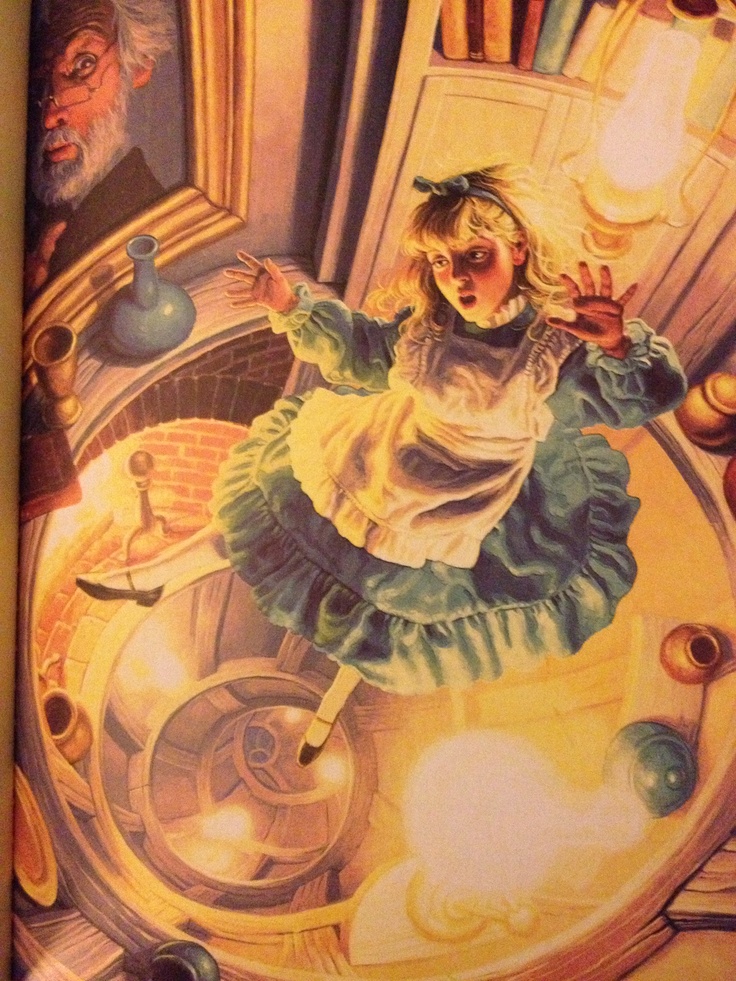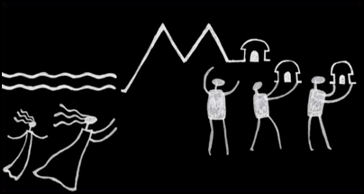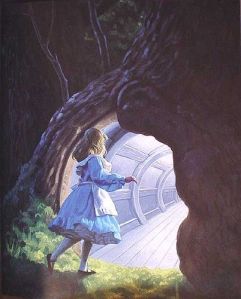You are currently browsing the category archive for the ‘Books’ category.
 I mention this in the guidebook for the Girls Underground Story Oracle, but was recently struck again by it – how often Alice in Wonderland shows up in one way or another within other Girls Underground stories. In fact, it’s usually a sign to me that I’ve correctly identified them as GU. My guess is that the authors (or occasionally screenwriters) involved are, on some level at least, aware of the archetype they are working with, even if they might not articulate it as such, and recognize Alice as part of the same pattern. I wish I had kept track, from the beginning of my exploration and collecting all the GU stories I could, of every time I encountered a direct reference to Alice: a quote, often, or a character being compared to some Wonderland denizen, or else the protagonist thinking how she feels like she’s gone down the rabbit hole or something of that nature. Alice is clearly the Girl Underground par excellence in many minds – certainly the most famous one – and one they naturally refer back to when their characters follow in her footsteps to some degree. It always makes me smile when she sneaks into whatever GU book I’m reading.
I mention this in the guidebook for the Girls Underground Story Oracle, but was recently struck again by it – how often Alice in Wonderland shows up in one way or another within other Girls Underground stories. In fact, it’s usually a sign to me that I’ve correctly identified them as GU. My guess is that the authors (or occasionally screenwriters) involved are, on some level at least, aware of the archetype they are working with, even if they might not articulate it as such, and recognize Alice as part of the same pattern. I wish I had kept track, from the beginning of my exploration and collecting all the GU stories I could, of every time I encountered a direct reference to Alice: a quote, often, or a character being compared to some Wonderland denizen, or else the protagonist thinking how she feels like she’s gone down the rabbit hole or something of that nature. Alice is clearly the Girl Underground par excellence in many minds – certainly the most famous one – and one they naturally refer back to when their characters follow in her footsteps to some degree. It always makes me smile when she sneaks into whatever GU book I’m reading.
In the Night Wood by Dale Bailey is not a Girls Underground book. It is a story about a man who, having lost much, becomes obsessed with uncovering a mystery behind the author of a strange Victorian fantasy tale called, of course, In the Night Wood. And that story, the book-within-a-book, appears to be a Girls Underground story.
“What would she do now? she asked herself as the fell King spurred his horse into a gallop and hurtled down the corridor of trees. She recalled too late the words the Knight of Ice had imparted to her at the end of his Tale: When you come to the end of your own Story, he had said, you must remember the thing that you have forgotten. But how could you remember the thing you had forgotten when you had forgotten to remember it? she wondered.
And then the Horned King was upon her.”
As you can see from this excerpt from the book-within-a-book, there is also a deep awareness of The Power of Story running through these recursive tales, which also grabbed my interest. And then, of course, there’s the gorgeous, very GU cover:

We don’t really get enough of the Victorian story to be 100% sure of its details, but there is a girl, and a journey into an otherworldly forest, and an Adversary. We get just enough tantalizing morsels to make me hope that Bailey will some day reveal the whole thing, much like Catherynne Valente spun out The Girl Who Circumnavigated Fairyland in a Ship of Her Own Making after fans begged her to expand on its mention in another of her books.
Bailey’s book is well worth reading beyond any GU connection. It handles the intermingling of folklore and the everyday very deftly, with an understanding of how mythic reality can manifest subtly at first, starting in the caverns of the mind and slowly bleeding out to take physical form. And how terrible and bloody it can be.
“It was cruel and cold and brutal and beautiful, and I would give anything to go back there. Maybe it broke me in some deep, intrinsic way that I am incapable of seeing….I don’t care. It was my home, and it finally let me be myself, and I hate it here.”
What happens to the Girl Underground after her adventure is over? Well, in a few glorious examples, she stays underground, but most of the time she ends up back in the “real world” either voluntarily (so many of them want so desperately to get home to their dull Kansas-like lands!) or as the natural conclusion to her journey. But what about those girls who never wanted to leave, and pine away for the magical world they left behind?
In Every Heart a Doorway, author Seanan McGuire introduces us to a boarding school made just for those girls (and a few boys) who stepped through a looking glass or went down an impossibly stairway inside a trunk, and ended up in a world they felt was truly “home” – only to get cast out again and be labeled “troubled” or even “insane” by confused parents.
Why mostly girls?
“Because ‘boys will be boys’ is a self-fulfilling prophecy…They’re too loud, on the whole, to be easily misplaced or overlooked; when they disappear from the home, parents send search parties to dredge them out of swamps and drag them away from frog ponds. It’s not innate. It’s learned. But it protects them from the doors, keeps them safe at home. Call it irony, if you like, but we spend so much time waiting for our boys to stray that they never have the opportunity. We notice the silence of men. We depend upon the silence of women.”
I don’t know that this is the full, true answer, but it may at least be part of it. Even more accurate, though, in my opinion, is her description of why the doors opened for these girls in the first place – and always into worlds that spoke to some deep, hidden part of themselves.
“Some doors really do appear only once, the consequence of some strange convergence that we can’t predict or re-create. They’re drawn by need and by sympathy. Not the emotion – the resonance of one thing to another. There’s a reason you were all pulled into worlds that suited you so well.”
She also speaks to how the journey changes a person. Those of us who understand the Power of Story and implement it in our lives will find this very familiar:
“The habit of narration, of crafting something miraculous out of the commonplace, was hard to break. Narration came naturally after a time spent in the company of talking scarecrows or disappearing cats; it was, in its own way, a method of keeping oneself grounded, connected to the thin thread of continuity that ran through all lives, no matter how strange they might become. Narrate the impossible things, turn them into a story, and they could be controlled.”
But no matter what they do, most of these girls won’t find their way back through their doors. Most Girls Underground return home and stay home, in the end. And for those who don’t want to, it must be excruciating. Especially as their memories and surety fade over time.
“My window is closing….Every day I wake up a little more linear, a little less lost, and one day I’ll be one of the women who says ‘I had the most charming dream,’ and I’ll mean it. [I’m] old enough to know what I’m losing in the process of being found.”
Every Heart a Doorway isn’t quite a Girls Underground story itself, but it cuts to the heart of this archetype in certain ways I’ve never seen before, and holds a lot of truth.
For over a decade now, I have traced the Girls Underground archetype as it appears again and again in literature, film, television, fairytales, comic books, art and mythology. This has revealed to me not only the power of this particular story, but the power of Story in general. This is not just a metaphor – I believe Story shapes reality itself. Not surprisingly, some of my favorite movies illustrate the sacred role of Story, and I have recently noted this trend and decided to share a brief list here with you all.

Labyrinth – the film that started the idea for Girls Underground begins with Sarah reading from a book (probably a play) called Labyrinth, the details of which (down to the dialogue) she then enacts when the real Goblin King comes for her brother.
The Neverending Story – Bastian is given a special book which turns out to be more than just a simple story. As he reads it, he becomes a part of it, and must save the storybook world from annihilation.
Lady in the Water – a creature named Story arrives from a mythical world to help a writer achieve his destiny. To save her from danger and return her home, the man caring for her must learn the fairytale from which she comes, and find the right people to act out its sacred roles.
Neverwas – Zach’s troubled father wrote a popular children’s book with him as the protagonist when he was younger. Now grown, he finds a delusional man who believes he is a character from the book, and thinks Zach will save his kingdom. However, there is more truth to the story than Zach ever imagined.
Big Fish – Will’s dying father has told tall tales about his life as long as he can remember. But not only is there more truth to his wild stories than Will could have believed, it is the power of the story itself that will give his father the finale he deserves.
The Fall – a little girl named Alexandria is recuperating at a hospital when she meets a man who begins to tell her a long tale. As her imagination bleeds story into reality, the man’s ulterior motives come to light. However, Alexandria wedges herself into the story, and eventually helps heal the man’s heart.
The Imaginarium of Doctor Parnassus – this is perhaps only an “honorable mention,” but during a flashback it is revealed that Doctor Parnassus was once part of a group of monks who ceaselessly told the stories that kept the world moving. When the devil tries to silence them, the world can survive only if people elsewhere are also telling stories.
And some Girls Underground books and movies that emphasize The Power of Story:
- Storybound by Melissa Burt
- Finding Serendipity by Angelica Banks
- Unwritten by Tara Gilboy
- The Wrinkled Crown by Anne Nesbet
- The Hazel Wood by Melissa Albert
- New Nightmare
- Candyman
- American Fable
- The Dark Stranger
- Inkheart
Reading Here Be Dragons: Exploring Fantasy Maps and Settings by Stefan Ekman, I came across the work of Farah Mendlesohn. In her book Rhetorics of Fantasy, Mendlesohn suggests all fantasy novels can be placed in one of four categories, based on how the fantastic is introduced into the story. As Ekman describes them:
“The portal-quest fantasy introduces the point-of-view character into a fantasy world, either from a version of our own world (through, for instance, a wardrobe) or from a place in the fantasy world that, like the reader’s world, is ‘small, safe and understood’ (such as the noneventful, comprehensible Shire). The story is told from this point of origin, and the reader learns about the alien world along with the main character(s). In immersive fantasy, the characters, unlike the reader, are at home in the strange world, and the world is described as if totally familiar; the reader has to puzzle out how it works from the clues that are given. Intrusive fantasy is set in a world (often our own) into which the fantastic intrudes, causing chaos and confusion. Neither protagonist nor reader is familiar with the fantastic intrusion, and the story is a process of coming to terms with it. The ghost story is a typical intrusion fantasy. In the final category, liminal fantasy, the reader’s expectations are used to create worlds where the commonplace comes across as strange and wonderful, and the alien is portrayed with an everyday triteness bordering on the blasé. These fantasies are stories in which stylistic manipulation is central to the experience of the fantastic.”
Girls Underground stories are almost all portal-quest fantasies. A crucial element of the archetype is the girl leaving behind her normal life for an adventure in a strange new land. Her volition in taking that first step across the threshold is key (and results in a quest with one of a limited set of common goals, such as rescue of a loved one). However, a smaller number of GU stories instead fit the intrusive fantasy category, where the otherness bleeds into her normal life and changes its course. To me, though, these are usually less effective examples.
There are several stories which would qualify as Girls Underground examples, if the female character were the primary protagonist. Here are just a few:
- Peter Pan by J.M. Barrie (Wendy)
- The Chronicles of Narnia by C.S. Lewis (Lucy)
- Neverwhere by Neil Gaiman (Door)
- The Riverman by Aaron Starmer (Fiona)
- Nightbreed (Lori)
- American Horror Story: Murder House (Violet)
- A Cure for Wellness (Hannah)
- Monsters, Inc. (Boo)
Just laugh and jump into the soft, warm pit.”
My mother came across this amazing book, The Vege-Men’s Revenge (pictures by Florence K. Upton, verses by Bertha Upton – a mother/daughter team – and originally published in 1897) and was nice enough to pass it on to me. This isn’t really a full-fledged Girls Underground example, as it’s missing most of the salient features, but it is a literal girl-goes-underground story, and it’s also awesomely weird and gruesome, so I just had to add it here.
It tells the story (entirely in rhyming verse!) of Poppy, who is out walking one day, planning to harvest some veggies from the garden, when she is accosted by a couple of anthropomorphic vegetables. They sweet talk her into following them down underground to their kingdom….

…then surprise her with a condemnation of her previous vegetable-eating habits, and begin their revenge. They plant her in the ground (one of the most beautiful pictures in the book):

…and tend her, and she grows into many different types of vegetable, all of which look like her (clothes and all).

Then they pick the Poppy-veggies, cook them, and eat them! After the feast (portrayed in the cover painting, above), they have a wild dance that flies around faster and faster until they all sort of explode in a bang – and it turns out to be all Poppy’s dream (which kind of says something about the strangeness of Poppy’s mind).
I’ll forgive the all-too-common “it was all a dream” ending, but I do love how Poppy’s reaction to this is to gleefully go ahead with her plans to harvest her vegetables, completely unfazed by the dream’s message.
I’d rather return to the world that I know!”










